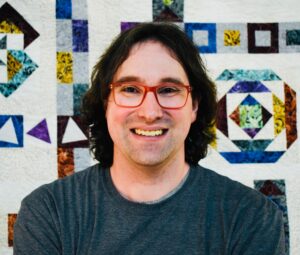 It is with great excitement and joy to I announce the release of my new fabric collection with Banayan Batiks, “QUILTING IS MY VOICE” coming to Quilt Stores in January 2024. This collection of fabric and the corresponding patterns I have designed are all based on my journey with Spasmodic Dysphonia.
It is with great excitement and joy to I announce the release of my new fabric collection with Banayan Batiks, “QUILTING IS MY VOICE” coming to Quilt Stores in January 2024. This collection of fabric and the corresponding patterns I have designed are all based on my journey with Spasmodic Dysphonia.
My journey with spasmodic dysphonia (SD) has been a series of extreme highs and lows over the past five years. On June 11, 2017, I woke up and noticed my voice was tired and a little scratchy. Over the next two weeks my loud voice that easily carried across a room become a choppy whisper that could barely be heard by people standing right next to me. At first, I blamed it on overuse, not using it correctly, and maybe a little laryngitis. After a couple of weeks, I finally went and saw my doctor and got an antibiotic and some steroids and figured in a week all would be better. When that didn’t work, I ended up seeing an ENT and then being referred to a Laryngologist at the University of Nebraska Medical Center, Dr. Christopher Bingcang. Over the following months we did a number of scopes, speech therapy, and started Botox Injections into the vocal cords (I have the best-looking vocal cords in the area, not a wrinkle to be seen!). While we were able to gain me some volume over time, the choppy-ness remained. In January of 2018, I got the official diagnosis of “Adductor Spasmodic Dysphonia”
Once I had this diagnosis many thoughts started racing through my mind “How am I going to do my job working at the Local Quilt Store; Teach quilting classes; how am I going to do Quilt Guild Presentations; and how is this going to affect my life as a quilter in general.
On October 18, 2018, I had the SLAD-R Surgery (Selective Laryngeal Adductor Denervation-Renervation) with Dr. Joel Blumin in Milwaukee, WI, to correct my SD. in layman’s terms: they decapitated me, severed the nerve on both sides of my neck that control speech and swallowing, hot-wired two new nerves up, and then put my head back on. This is a risky surgery in that there is no guarantee that the nerves will reconnect, and it has a lengthy recovery. This is only one of three surgical options available to correct SD, and of the three has the highest success rate (90%). My voice finally returned in May of 2019 and was 95% back to normal. In November 2020 though I heard the tell-tale crackle in my voice, and within a week, I had lost my voice again. At first, we were hoping it was just some Muscle Tension Dysphonia. but after some speech therapy, voice rest, more scopes and the dreaded “rainbow reading”. it was decided that my SD had returned. Surgery is no longer an option, so I am back to doing quarterly Botox injections into the vocal cords that gain me a little reprieve.
Through this journey, though, quilting has become my voice. It has helped me both face the disorder with a positive attitude and inner resolve to not give up or let it control my life. Thanks to the support of my local quilt community but also the larger quilting community. It has also given me the ability to be a spokesman and advocate for Dysphonia International and everyone living with spasmodic dysphonia. All the patterns in this collection have names that mean something to me and help tell my story.
In honor of all the people living with voice disorders, I will be donating 10% of all fabric and pattern sales from this collection to Dysphonia International to support research into treatment and cures.
WHAT IS SPASMODIC DYSPHONIA?
Spasmodic dysphonia (SD) is a neurological disorder in a category called dystonias. A dystonia is a movement disorder that causes muscles to contract and spasm involuntarily. When a person with SD attempts to speak, involuntary spasms in the tiny muscles of the larynx cause the voice to break up, or sound strained, tight, strangled, breathy, or whispery. The spasms often interrupt the sound, squeezing the voice to nothing in the middle of a sentence, or dropping it to a whisper. However, during other activities, such as breathing and swallowing, the larynx functions normally.
Spasmodic dysphonia is estimated to affect approximately 40,000-50,000 people in North America. Although it can start at any time during life, SD seems to begin more often between the ages of 30 and 50. The disorder affects women more often than men (less than 5%). Onset is usually gradual, with no obvious explanation. Symptoms usually occur in the absence of any structural abnormality of the larynx, such as nodules, polyps, carcinogens, or inflammation. People have described their symptoms as worsening over an approximately 18-month period and then remaining stable in severity from that point onward. Some people have reported brief periods of remission; however, this is very rare, and the symptoms usually return.
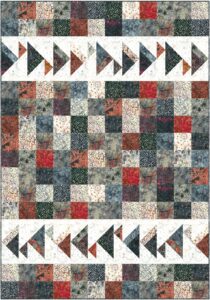
Changes in Seasons II
As for the inspiration for the pattern “Changes in Seasons II”. First of all, Flying Geese are one of my favorite quilt units to make, and then also Geese use their “voice” to signal the change of a season to us as they fly south for the winter and north for the summer, much like my voice is signaling another change in this season of my life. The top and bottom rows of this quilt are based on the Choppy Flying Geese that I use in my Logo.
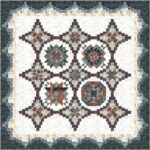
Soaring Voices Sampler
I am known for my Sampler Style quilts, so I knew I have to design something special for this collection. Before my SD started, I had sung in choirs from middle school through college and beyond and even went to college on a voice scholarship. While singing is no longer an option for me, listening to a choir or congregation sing and combine their voices into one and hear the voices and music soar in the room is one of my greatest joys in life, and I think I appreciate it more now than I did when I was able to sing.
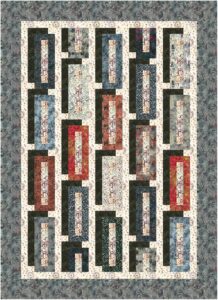 Many Voices
Many Voices
As I mentioned earlier, my SD Journey has been a series of Highs and Lows. Through those times, my voice has sounded like many different people. There is the voice I started with prior to SD, there was the hellish six months of decline when I could barely squeak out anything, and if I did, it was a whisper at best, there was the random voices and pitch changes you get after Botox injections (think middle school voice changes every 3-4 months), don’t want to forget the six months of no voice following surgery, the improved voice from surgery, back to Botox voice, and currently we have found a dose of Botox that works, and I sound like I did prior to SD.
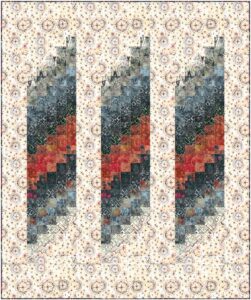
Please Repeat
This triptych-inspired quilt has dual meaning. First of all the bargello effect is broken into three parts because SD causes our voices to be choppy and nothing comes out as one word it comes out in pieces and parts. Second, because of this choppiness, we are constantly asked to repeat what we have said, over, and over, and over!
